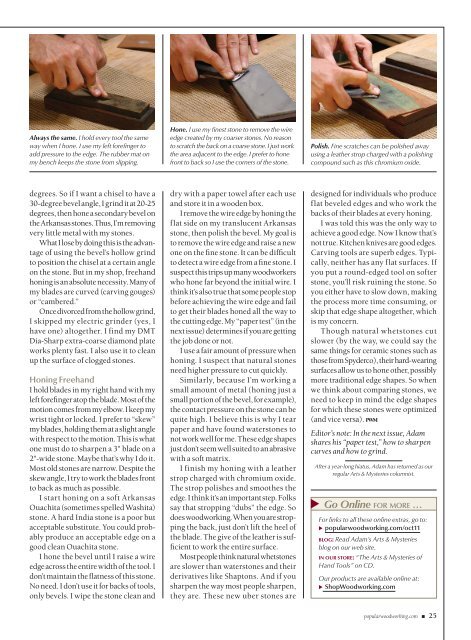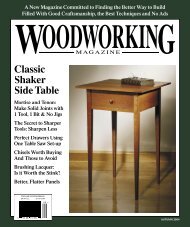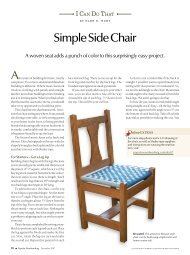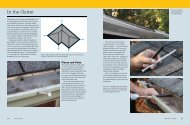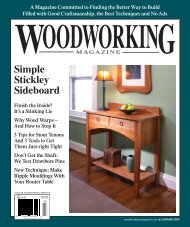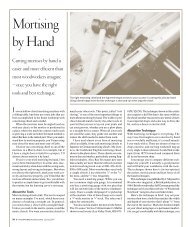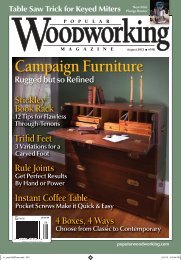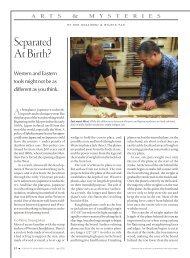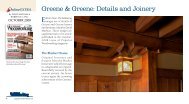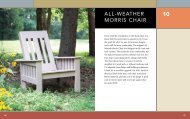Whetstone sharpening (PDF) - Popular Woodworking Magazine
Whetstone sharpening (PDF) - Popular Woodworking Magazine
Whetstone sharpening (PDF) - Popular Woodworking Magazine
You also want an ePaper? Increase the reach of your titles
YUMPU automatically turns print PDFs into web optimized ePapers that Google loves.
Always the same. I hold every tool the same<br />
way when I hone. I use my left forefi nger to<br />
add pressure to the edge. The rubber mat on<br />
my bench keeps the stone from slipping.<br />
degrees. So if I want a chisel to have a<br />
30-degree bevel angle, I grind it at 20-25<br />
degrees, then hone a secondary bevel on<br />
the Arkansas stones. Thus, I’m removing<br />
very little metal with my stones.<br />
What I lose by doing this is the advantage<br />
of using the bevel’s hollow grind<br />
to position the chisel at a certain angle<br />
on the stone. But in my shop, freehand<br />
honing is an absolute necessity. Many of<br />
my blades are curved (carving gouges)<br />
or “cambered.”<br />
Once divorced from the hollow grind,<br />
I skipped my electric grinder (yes, I<br />
have one) altogether. I find my DMT<br />
Dia-Sharp extra-coarse diamond plate<br />
works plenty fast. I also use it to clean<br />
up the surface of clogged stones.<br />
Honing Freehand<br />
I hold blades in my right hand with my<br />
left forefi nger atop the blade. Most of the<br />
motion comes from my elbow. I keep my<br />
wrist tight or locked. I prefer to “skew”<br />
my blades, holding them at a slight angle<br />
with respect to the motion. This is what<br />
one must do to sharpen a 3" blade on a<br />
2"-wide stone. Maybe that’s why I do it.<br />
Most old stones are narrow. Despite the<br />
skew angle, I try to work the blades front<br />
to back as much as possible.<br />
I start honing on a soft Arkansas<br />
Ouachita (sometimes spelled Washita)<br />
stone. A hard India stone is a poor but<br />
acceptable substitute. You could probably<br />
produce an acceptable edge on a<br />
good clean Ouachita stone.<br />
I hone the bevel until I raise a wire<br />
edge across the entire width of the tool. I<br />
don’t maintain the fl atness of this stone.<br />
No need. I don’t use it for backs of tools,<br />
only bevels. I wipe the stone clean and<br />
Hone. I use my fi nest stone to remove the wire<br />
edge created by my coarser stones. No reason<br />
to scratch the back on a coarse stone. I just work<br />
the area adjacent to the edge. I prefer to hone<br />
front to back so I use the corners of the stone.<br />
dry with a paper towel after each use<br />
and store it in a wooden box.<br />
I remove the wire edge by honing the<br />
flat side on my translucent Arkansas<br />
stone, then polish the bevel. My goal is<br />
to remove the wire edge and raise a new<br />
one on the fi ne stone. It can be diffi cult<br />
to detect a wire edge from a fi ne stone. I<br />
suspect this trips up many woodworkers<br />
who hone far beyond the initial wire. I<br />
think it’s also true that some people stop<br />
before achieving the wire edge and fail<br />
to get their blades honed all the way to<br />
the cutting edge. My “paper test” (in the<br />
next issue) determines if you are getting<br />
the job done or not.<br />
I use a fair amount of pressure when<br />
honing. I suspect that natural stones<br />
need higher pressure to cut quickly.<br />
Similarly, because I’m working a<br />
small amount of metal (honing just a<br />
small portion of the bevel, for example),<br />
the contact pressure on the stone can be<br />
quite high. I believe this is why I tear<br />
paper and have found waterstones to<br />
not work well for me. These edge shapes<br />
just don’t seem well suited to an abrasive<br />
with a soft matrix.<br />
I finish my honing with a leather<br />
strop charged with chromium oxide.<br />
The strop polishes and smoothes the<br />
edge. I think it’s an important step. Folks<br />
say that stropping “dubs” the edge. So<br />
does woodworking. When you are stropping<br />
the back, just don’t lift the heel of<br />
the blade. The give of the leather is suffi<br />
cient to work the entire surface.<br />
Most people think natural whetstones<br />
are slower than waterstones and their<br />
derivatives like Shaptons. And if you<br />
sharpen the way most people sharpen,<br />
they are. These new uber stones are<br />
Polish. Fine scratches can be polished away<br />
using a leather strop charged with a polishing<br />
compound such as this chromium oxide.<br />
designed for individuals who produce<br />
flat beveled edges and who work the<br />
backs of their blades at every honing.<br />
I was told this was the only way to<br />
achieve a good edge. Now I know that’s<br />
not true. Kitchen knives are good edges.<br />
Carving tools are superb edges. Typically,<br />
neither has any flat surfaces. If<br />
you put a round-edged tool on softer<br />
stone, you’ll risk ruining the stone. So<br />
you either have to slow down, making<br />
the process more time consuming, or<br />
skip that edge shape altogether, which<br />
is my concern.<br />
Though natural whetstones cut<br />
slower (by the way, we could say the<br />
same things for ceramic stones such as<br />
those from Spyderco), their hard-wearing<br />
surfaces allow us to hone other, possibly<br />
more traditional edge shapes. So when<br />
we think about comparing stones, we<br />
need to keep in mind the edge shapes<br />
for which these stones were optimized<br />
(and vice versa). PWM<br />
Editor’s note: In the next issue, Adam<br />
shares his “paper test,” how to sharpen<br />
curves and how to grind.<br />
After a year-long hiatus, Adam has returned as our<br />
regular Arts & Mysteries columnist.<br />
u<br />
Go Online FOR MORE …<br />
For links to all these online extras, go to:<br />
u popularwoodworking.com/oct11<br />
BLOG: Read Adam’s Arts & Mysteries<br />
blog on our web site.<br />
IN OUR STORE: “The Arts & Mysteries of<br />
Hand Tools” on CD.<br />
Our products are available online at:<br />
u Shop<strong>Woodworking</strong>.com<br />
popularwoodworking.com ■ 25


